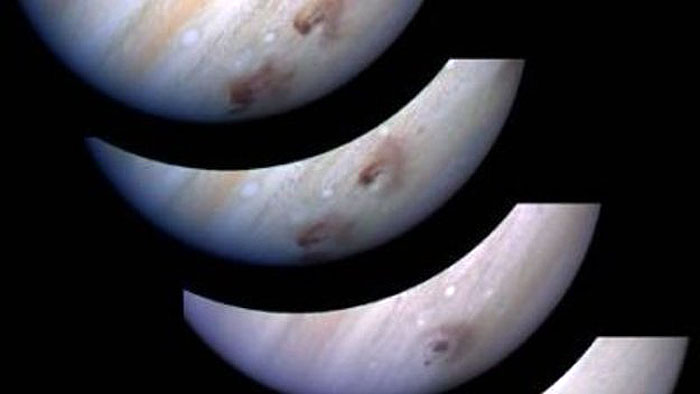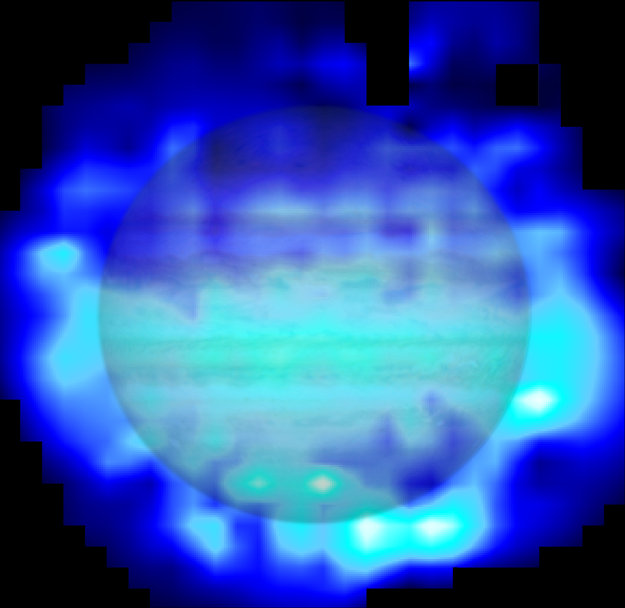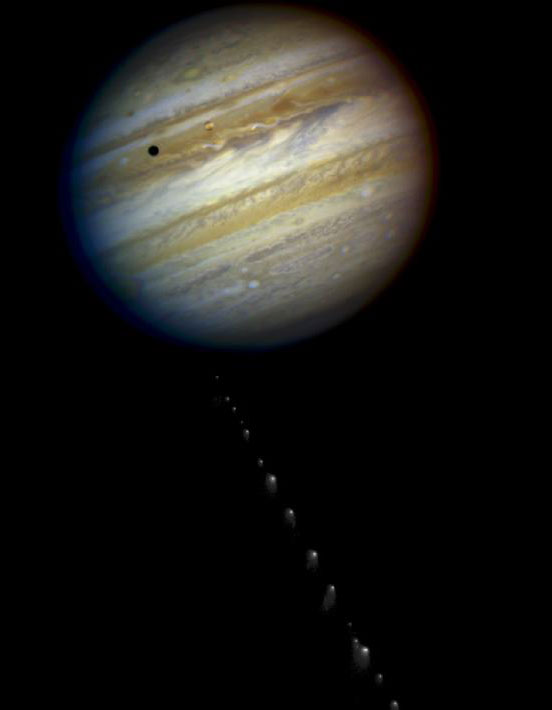.
24.04.2013

Shoemaker-Levy 9 impact site G
.
ESA’s Herschel space observatory has solved a long-standing mystery as to the origin of water in the upper atmosphere of Jupiter, finding conclusive evidence that it was delivered by the dramatic impact of comet Shoemaker-Levy 9 in July 1994.
During the spectacular week-long collision, a string of 21 comet fragments pounded into the southern hemisphere of Jupiter, leaving dark scars in the planet’s atmosphere that persisted for several weeks.
The remarkable event was the first direct observation of an extraterrestrial collision in the Solar System. It was followed worldwide by amateur and professional astronomers with many ground-based telescopes and the NASA/ESA Hubble Space Telescope.
ESA’s Infrared Space Observatory was launched in 1995 and was the first to detect and study water in Jupiter’s upper atmosphere. It was widely speculated that comet Shoemaker-Levy 9 may have been the origin of this water, but direct proof was missing.
Scientists were able to exclude an internal source, such as water rising from deeper within the planet’s atmosphere, because it is not possible for water vapour to pass through the ‘cold trap’ that separates the stratosphere from the visible cloud deck in the troposphere below.
Thus the water in Jupiter’s stratosphere must have been delivered from outside. But determining its origin had to wait more than 15 years, until Herschel used its sensitive infrared eyes to map the vertical and horizontal distribution of water’s chemical signature.
.

Water in Jupiter’s atmosphere
.
Herschel’s observations found that there was 2–3 times more water in the southern hemisphere of Jupiter than in the northern hemisphere, with most of it concentrated around the sites of the 1994 comet impact. Additionally, it is only found at high altitudes.
“Only Herschel was able to provide the sensitive spectral imaging needed to find the missing link between Jupiter’s water and the 1994 impact of comet Shoemaker-Levy 9,” says Thibault Cavalié of the Laboratoire d’Astrophysique de Bordeaux, lead author of the paper published in Astronomy and Astrophysics.
“According to our models, as much as 95% of the water in the stratosphere is due to the comet impact.”
Another possible source of water would be a steady rain of small interplanetary dust particles onto Jupiter. But, in this case, the water should be uniformly distributed across the whole planet and should have filtered down to lower altitudes.
Also, one of Jupiter’s icy moons could deliver water to the planet via a giant vapour torus, as Herschel has seen from Saturn’s moon Enceladus, but this too has been ruled out. None of Jupiter’s large moons is in the right place to deliver water to the locations observed.
.
Quelle: ESA
.
Update: 25.04.2013
.
Astronomers have finally found direct proof that almost all water present in Jupiter's stratosphere, an intermediate atmospheric layer, was delivered by comet Shoemaker-Levy 9, which famously struck the planet in 1994.
The findings, based on new data from the Herschel space observatory, reveal more water in Jupiter's southern hemisphere, where the impacts occurred, than in the north. Herschel is a European Space Agency mission with important NASA participation.
The origin of water in the upper atmospheres of the solar system's giant planets has been debated for almost two decades. Astronomers were quite surprised at the discovery of water in the stratospheres of Jupiter, Saturn, Uranus and Neptune, which dates to observations performed with ESA's Infrared Space Observatory in 1997.
While the source of water in the lower layers of their atmospheres can be explained as internal, the presence of this molecule in their upper atmospheric layers is puzzling due to the scarcity of oxygen there. Its supply must have an external origin. Since then, astronomers have investigated several possible candidates that may have delivered water to these planets, from icy rings and satellites to interplanetary dust particles and cometary impacts.
Data from Herschel's Photodetecting Array Camera and Spectrometer (PACS), with the help of NASA's Infrared Telescope Facility, helped solve the mystery at Jupiter by showing an asymmetry in the distribution of water in its stratosphere, caused by the comet impact. Additional proof for a cometary source for the water came from Hershel's heterodyne instrument for the far infrared (HIFI), which probed the vertical profile of water in the stratosphere. NASA's Jet Propulsion Laboratory in Pasadena, Calif., helped build the HIFI instrument.
"The asymmetry between the two hemispheres suggests that water was delivered during a single event and rules out icy rings or moons as candidate sources," says Thibault Cavalié from the Laboratoire d'Astrophysique de Bordeaux, France, who led the study. "Local sources would provide a steady supply of water, which over time would lead to a hemispherically symmetric distribution in the stratosphere. Depending on whether the chemical species are transported in neutral or ionized form, local sources of water would result in higher concentrations either at the poles or along the equator, but not in a north-south asymmetry."
.

Comet Shoemaker-Levy 9 Approaching Jupiter in 1994
This is a composite photo, assembled from separate images of Jupiter and comet Shoemaker-Levy 9, as imaged by the NASA/ESA Hubble Space Telescope in 1994.
Comet Shoemaker-Levy 9 was discovered by astronomers Carolyn and Eugene M. Shoemaker and David Levy on March 24, 1993. It was the first comet observed to be orbiting a planet -- in this case, Jupiter -- rather than the sun. The effect of Jupiter's tidal forces had already torn the celestial body apart and, eventually, the fragments collided with Jupiter between July 16 and 22, 1994.
The image of the comet, showing 21 fragments, was taken on May 17, 1994. The image of Jupiter was taken on May 18, 1994. The dark spot on the planet is the shadow of the inner moon lo. The apparent angular size of Jupiter relative to the comet, and its angular separation from the comet when the images were taken, have been modified for illustration purposes.
Herschel is a European Space Agency mission, with science instruments provided by consortia of European institutes and with important participation by NASA. NASA's Herschel Project Office is based at NASA's Jet Propulsion Laboratory, Pasadena, Calif. JPL contributed mission-enabling technology for two of Herschel's three science instruments. The NASA Herschel Science Center, part of the Infrared Processing and Analysis Center at the California Institute of Technology in Pasadena, supports the United States astronomical community. Caltech manages JPL for NASA.
.
Quelle: NASA
5584 Views
